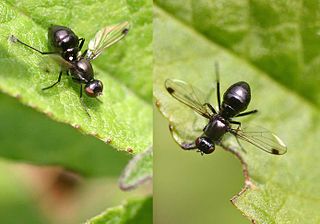
The Sepsidae are a family of flies, commonly called the black scavenger flies or ensign flies. Over 300 species are described worldwide. They are usually found around dung or decaying plant and animal material. Many species resemble ants, having a "waist" and glossy black body. Many Sepsidae have a curious wing-waving habit made more apparent by dark patches at the wing end.

Calyptratae is a subsection of Schizophora in the insect order Diptera, commonly referred to as the calyptrate muscoids. It consists of those flies which possess a calypter that covers the halteres, among which are some of the most familiar of all flies, such as the house fly.

The Anthomyiidae are a large and diverse family of Muscoidea flies. Most look rather like small houseflies, but are commonly drab grey. The genus Anthomyia, in contrast, is generally conspicuously patterned in black-and-white or black-and-silvery-grey. Most are difficult to identify, apart from a few groups such as the kelp flies that are conspicuous on beaches.

The Fanniidae are a small group of true flies largely confined to the Holarctic and temperate Neotropical realms; there are 11 Afrotropical species, 29 Oriental, and 14 Australasian.

Musca autumnalis, the face fly or autumn housefly, is a pest of cattle and horses.

Fannia is a very large genus of approximately 288 species of flies. The genus was originally described by the French entomologist Jean-Baptiste Robineau-Desvoidy in 1830. A number of species were formerly placed in the genus Musca.
Euryomma is a genus of species of flies of the family Fanniidae. The genus was originally proposed by the entomologist Paul Stein in 1899. Although at that time most authorities placed them in the family Muscidae. The distribution of Euryomma is mainly Neotropical, on the whole restricted to the Americas, there is also one Nearctic species, the exception being of the very cosmopolitan E. peregrinum
Australofannia is a genus of flies of the family Fanniidae. There is only one known species, Australofannia spiniclunis Pont, 1977, from southeastern Australia. The genus was first described by the English entomologist Adrian C. Pont in 1977.
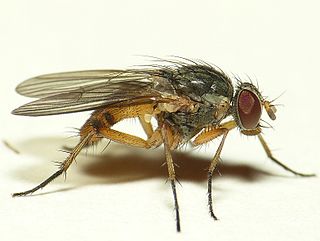
Piezura is a small genus of small flies of the family Fanniidae. Distribution is mostly restricted to the Holarctic biogeographic region. Two species, P. pardalina and P. graminicola are found in Europe. Unlike the other Fanniidae, Piezura have plumose arista.
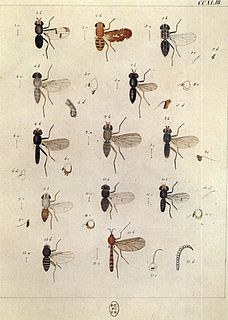
Euryomma peregrinum is a small species of flies from the family Fanniidae. It is the type species of the genus Euryomma and was originally described by the German entomologist Johann Wilhelm Meigen, in 1826. Although he placed it in another genus.

Adia is a genus of flies in the family Anthomyiidae.
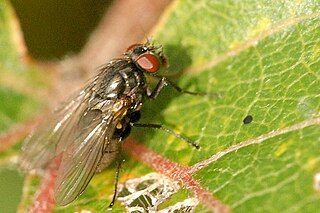
Fannia armata is a fly species in the Fanniidae family. This species is smaller and more slender than the house fly, Musca domestica, and is similar in appearance to the lesser house fly, Fannia canicularis. It is found in the Palearctic. For identification see
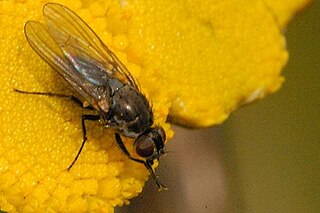
Fannia lepida is a fly species in the Fanniidae family. This species is smaller and more slender than the house fly, Musca domestica, and is similar in appearance to the lesser house fly, Fannia canicularis. It is found in the Palearctic. For identification see

Fannia sociella is a fly species in the Fanniidae family. This species is smaller and more slender than the house fly, Musca domestica, and is similar in appearance to the lesser house fly, Fannia canicularis. It is found in the Palearctic. For identification see
Australofannia spiniclunis is a fly species in the Fanniidae family. It is the only known species of the genus Australofannia from Southeastern Australia. The species was first described by the English entomologist Adrian C. Pont in 1977.
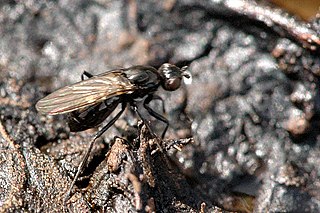
Themira putris is a European species of fly and member of the family Sepsidae.
Euryomma muisca is a species of fly in the genus Euryomma. It was first described by Grisales et al. in 2012.

Fannia mollissima is a species of fly in the family Fanniidae. It is found in the Palearctic. For identification see

Fannia rondanii is a species of fly in the family Fanniidae. It is found in the Palearctic. For identification see
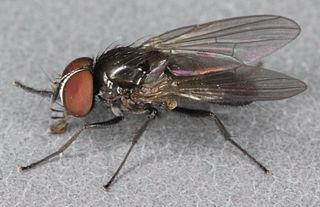
Fannia serena is a species of fly in the family Fanniidae. It is found in the Palearctic. For identification see














